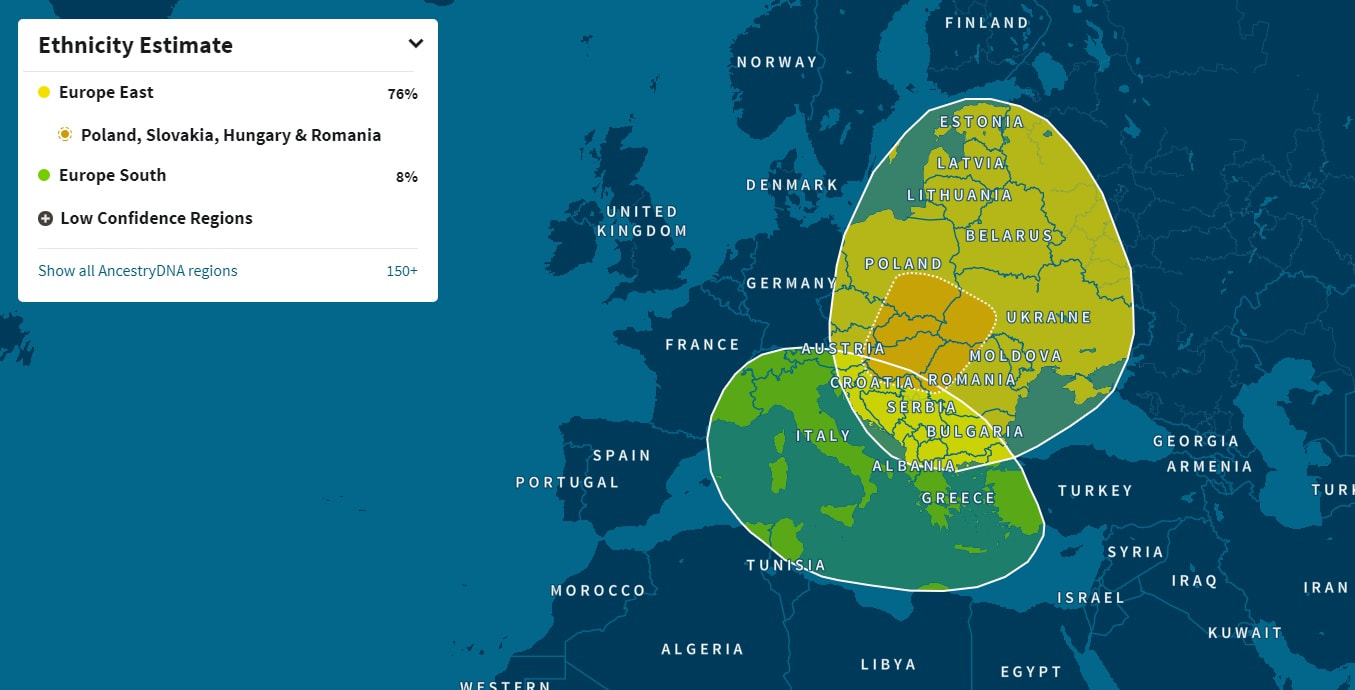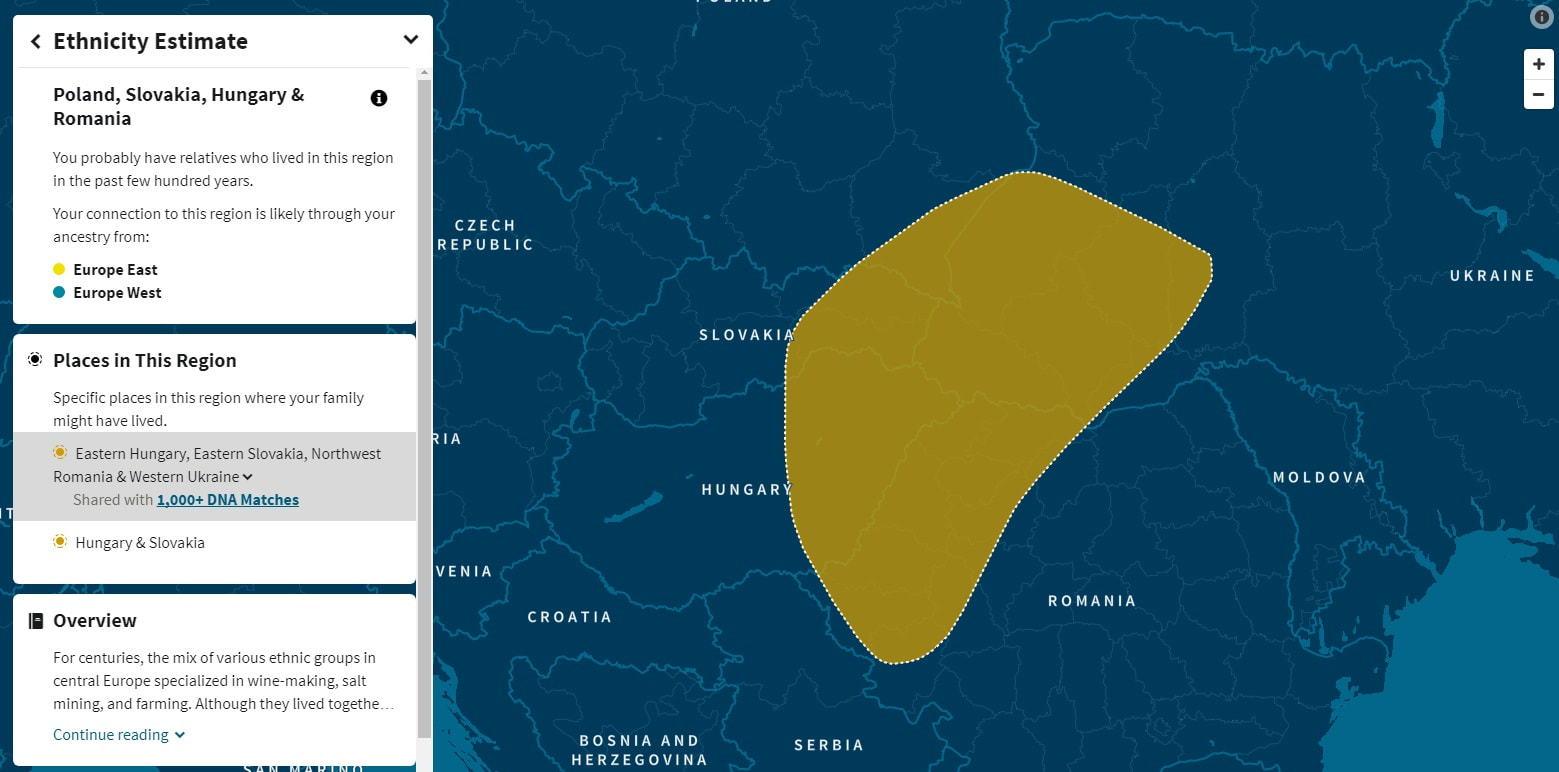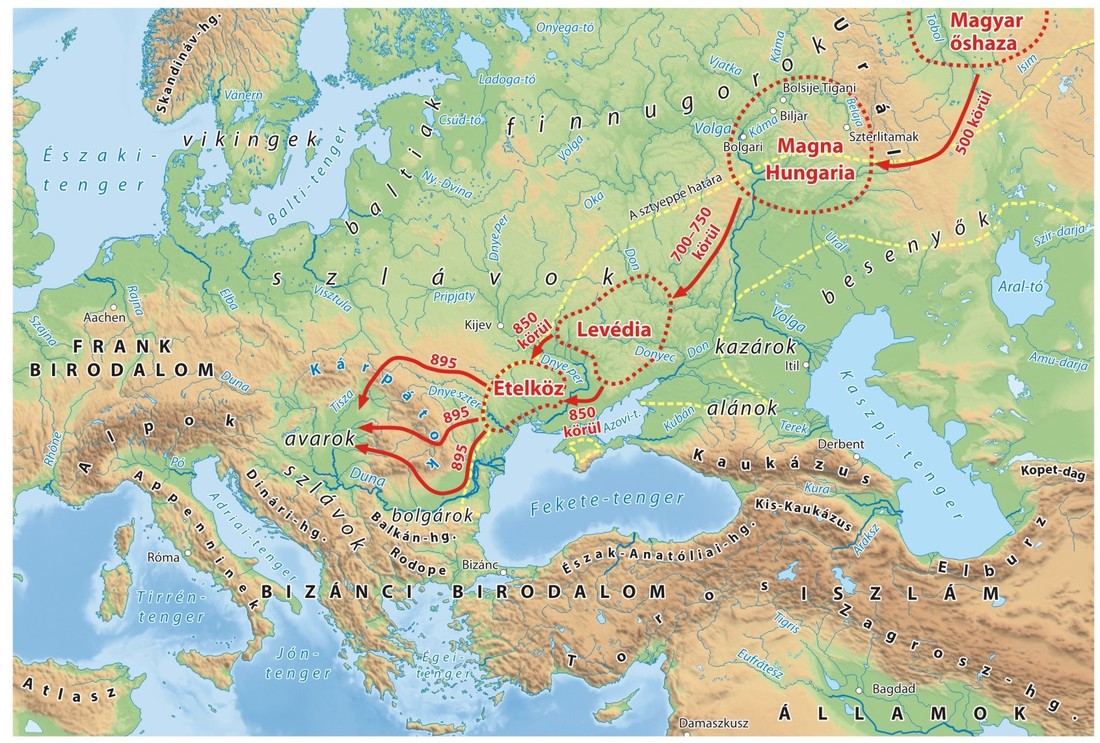|
In 895 AD, a Finno-Ugric speaking horse people fled from their enemies on the Great Steppe and swept into the Pannonian Basin in Central Europe. From there, these terrifying nomads raided and pillaged across much of Europe, reminding their neighbors so much of Atilla and the Huns that they named them the Hungarians. Growing up in Canada, I've learned a lot about British Isles with the Celts, Anglo-Saxons, Vikings and Normans but Eastern Europe was mysterious and insufficiently western. Further, recorded history in Eastern Europe doesn't really begin until Christianization and before then, historians rely on the records of Greek, Roman, and Byzantine sources. So other than someone from Hungary, what is an Hungarian? Can a DNA test tell us? According to Ancestry DNA, my 100% ethnically Hungarian mother is 76% East European, 8% South European, 3% Central Asian and the rest northern and western European. Ancestry arrived at that conclusion by comparing my mother's autosomal DNA, which is to say the 99% of her DNA that is a combination of her mother's and father's autosomal DNA, to the autosomal DNA of thousands of people living across the world who can trace their family history back many generations in the same geographic area in which they live. "Eastern European" is a pretty broad description but it appears as if Hungarians aren't genetically distinct enough from Ukrainians, Bulgarians, or Slovaks to easily tell them apart. Interestingly, Ancestry has another ethnicity estimating tool that uses her closer genetic matches on Ancestry DNA, most of whom live today in the United States and Canada. Looking at the shared DNA between these matches as well as the recorded birth places of their ancestors, Ancestry not only narrowed down the location of my mother's family to Hungary but to Eastern Hungary. However, this estimate looks back on two or three hundred years and really doesn't reveal much new. However, for DNA testers who have less information about their family tree, it could be quite useful. DNA testing at 23andme and Family Tree DNA provide slightly different but broadly similar results. Y-DNA testing at Family Tree DNA allows a much deeper dive into the past, since the Y-Chromosome doesn't combine DNA from the mother and father with each generation but is exclusively passed from father to son. Down my paternal line, my Y-Chromosome is almost identical to that of my father, 10x great grandfather, 20x great-grandfather and so on. I write "almost" because it did slowly and randomly mutate over time. By comparing Y-chromosomes between large numbers of men, researchers created a tree of very roughly when and where these mutations had occured. My Mom's father was a Daku and her mother was a Debreceni. My Debreceni cousin has a series of mutations in his Y-DNA that researchers named R1b-U106. This "haplogroup" is very common among men of German descent and researchers believe that everyone in it shares a proto-Germanic ancestor who lived a few thousand years ago. Further, my cousin's paternal descent is entirely Hungarian but this haplogroup is rare in Hungary today. My Daku cousin is in a haplogroup named R1b-U152, which is very common among men who live in or near the Alps, including Switzerland and Italy. Researchers believe that then men in this group share an ancestor who is proto-Celtic and my cousin's closest Y-DNA match is an Italian man with whom he likely shared a common ancestor who lived 2,000 years ago. Again, however, this haplogroup is rare in Hungary. Mitochondria are organelles which live in each and every one of your cells, consuming oxygen to provide your cells the energy they need to function. They has their own distinct DNA, completely separate from our DNA. Every animal on Earth inherited all of their mitochondria from their mother and their DNA never combined with any other DNA, making it a useful indicator like Y-DNA. However, it mutates much more slowly than Y-DNA, making it a far less precise indicator. If I could test the mitochondrial DNA (mtDNA) of my 20x great-grandmother down my maternal line, hers would be nearly identical to mine, with perhaps only a small difference or two. My mtDNA haplogroup is named HV6a, which is a very rare group anywhere. My closest mtDNA match has recent ancestry in the Ukraine, which is not unexpected. Other, slightly less close, matches have ancestry in Eastern Europe, which is also not unexpected. And then I have 2 matches, which whom I probably share a common ancestor over a thousand years ago, who are from Finland. Finland? Interestingly, when looking at my mother's autosomal DNA, she matches several people who live in Finland and Sweden. The sizable DNA segments they share are not likely inherited from any recent ancestor, however, but are common in both populations, meaning a connection much further in the past. Using DNA to determine your ethnicity is a tricky endeavor. If a test indicates that you're Irish, German or Scandinavian, what does that mean? When discussing these peoples, we are referring to cultural and linguistic identities, as opposed to genetic ones. These peoples settled across large territories and migrated frequently, meaning that several groups may have been absorbed into their tribes. To be English today means that you are Celt, Anglo-Saxon, Viking, and Norman and each of these cultures may be broken down even further. Likewise, although my Mom is only 76% East European, it doesn't mean she's not 100% Hungarian or that she has non-Hungarian great grandfather somewhere. Her family might be 100% Hungarian for many, many generations and still get that admixture because some German is part of every Hungarian's DNA. It's part of East European DNA. So what makes up an Hungarian? All of my Mom's grandparents were born in the Kingdom of Hungary in the late 19th century. While Hungary was culturally and politically distinct, it was also a melting pot of many different peoples. As we've noted, genetically, Hungarians are similar to the West Slavic countries that surround them, with the exception that they have a slightly higher percentage of Central and East Asian DNA, which is consistent with the conquest of the Magyars. From 400 BC to 150 BC, the lands of modern Hungary were peopled by successive Celtic tribes. However, about 150 BC, the Roman Empire encroached into the region, conquering the basin all the way to the Danube. The Romans named this province Pannonia, which possibly derived from the language of a local people, meaning "swamp, water, or wet". If you look at older maps of Hungary, you might notice there are a tremendous number of marshlands. While Romans did settle some of their own people in distant colonies, they also encouraged allies to settle on their borders and so arrived the East Germanic Vandals and Goths, along with the nomadic Eurasian Avars from the Steppe. Hundreds of years later, when the borders of the Roman Empire shrank back in response to attacks from the Huns, the Avars established a Khanate across the region, including in Hungary, Bulgaria, Serbia, Ukraine, and Slovakia. With one exception, the nomads who came from the Great Eurasian Steppe were a Turkish-speaking, Eurasian people who travelled great distances from east to west, seeking pasture and trade. They were a vital connection between several geographically separated peoples, transmitting culture, technology and language between China, the Muslim States, the Byzantine Empire, and Europe. However, while fierce, invincible warriors, they were comparatively few in number. This nomadic culture had dominated the steppe for several thousand years and would continue to dominate it until the end of the Mongol era, hundreds of years later. In Eastern Europe, the nomads coexisted with the Slavs, a forest dwelling people, not unlike the Celtic or Germanic tribes, who raided and plundered the Greeks and Romans for centuries. However, unlike these other tribes, Slavs also had to contend with the nomads. For many years, nomads traded with the Slavs but also raided them for goods, cattle or slaves, which the nomads sold into the Muslim world. Germanic or Viking invaders would also seize and sell Slavs to the nomads, and even the Slavs sold their fellow Slavs. In fact, there was such a large trade that Slav became the word for slave in many languages. After the Avar Khanate diminished, the nomadic Bulgars, Slavic Moravians, and Eastern Franks from across the Alps fought for control of Pannonia. However, regardless of who won these wars, the Slavs became the dominant population and, over time, they assimilated all the others, making the region culturally and linguistically Slavic, even Hungary. Until the Magyar arrived. The Magyar were once a forest dwelling people in the north of the Ural Mountains, who spoke a Finno-Ugric language, like the people of Finland and Estonia. Over time, seven tribes of the Magyar became nomadic, and payed homage to the Khazzar Khans, which dominate the western part of the great steppe. About 850 AD, they migrated south to the lands between the Dnieper and the Black Sea and became independent, being joined by some Turkish tribes. However, they were not to stay on the steppe for long. The fierce Magyar were a trouble-making people who attacked and pillaged their neighbors, the Byzantine Empire, who resolved to deal with them. The Empire made a pact with the Pechenegs, yet another Turkish nomadic people, and attacked the Magyar, driving them west into the Pannonian Basin.
Unlike what happened with the Avars and Bulgars, the Magyar elite imposed their language and much of their culture on the local population, making Hungary the only non-Slavic nation in the region. A parallel would be if part of the British Isles retained the Norse Viking culture rather than being assimilated by the local people. The Magyar continued to raid Europe for several decades until the King of East Francia finally defeated and exterminated a large Hungarian army in 955 AD. Aftwards, Hungary accepted western Roman Christianity, in contrast to most of the Slavic nations who accepted eastern Byzantine Christianity, and became a Christian Kingdom. For the last thousand years, despite absorbing new nomadic tribes such as the Cumans, suffering crushing losses to the Mongols, and being conquered by the Ottoman and Austrian Empires, Hungary has remained politically, socially, and linguistically distinct. So what is an Hungarian? Ethnically, they are mostly Slavic but likely has inherited some DNA from many of the peoples of the wider regions, including Celts, Germans, Romans, Greeks, and Eurasian Turks. So while my Hungarian genetic roots are mostly Slavic, it's also East Germanic, Turkish, and Mediterranean. Considering the U152 haplogroup of my Daku cousin, perhaps there are even some ancient Celtic ancestry mixed in there. That Celtic line may have been in Hungary for over 2,000 years or may have come later with different invader groups, such as the Romans. As to my mtDNA, it seems to me that it might, perhaps, be Magyar, the nomads from the north who share a common language group with the people from Finland. There appears to be autosomal DNA connection there as well. It would be nice to have some proof of Magyar in there somewhere. |
Archives
2023 JAN FEB MAR APR MAY JUN JUL AUG SEP 2022 JAN FEB MAR APR MAY JUN JUL AUG SEP OCT NOV DEC 2021 JAN FEB MAR APR MAY JUN JUL AUG SEP OCT NOV DEC 2020 JAN FEB MAR APR MAY JUN JUL AUG SEP OCT NOV DEC 2019 JAN FEB MAR APR MAY JUN JUL AUG SEP OCT NOV DEC 2018 JAN FEB MAR APR MAY JUN JUL AUG SEP OCT NOV DEC 2017 JAN FEB MAR APR MAY JUN JUL AUG SEP OCT NOV DEC 2016 JAN FEB MAR APR MAY JUN JUL AUG SEP OCT NOV DEC 2015 JAN FEB MAR APR MAY JUN JUL AUG SEP OCT NOV DEC 2014 OCT NOV DEC Categories |



 RSS Feed
RSS Feed